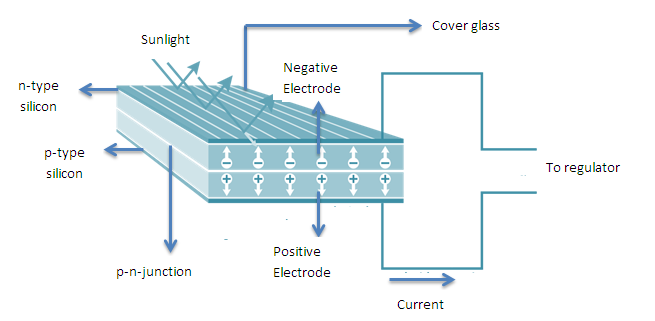Summary: A solar cell is the smallest unit of a solar power system. Many solar cells make a solar panel.
A solar cell is the basic electricity generating unit of the solar photovoltaic system.
You would have surely heard about Solar Cells? What are solar cells, how are they made and how do they generate electricity?
Solar cells form the basic electricity generating unit of the solar photovoltaic system.
Solar cells come in different sizes. Solar cells from prominent suppliers today are 100-150 mm square, and have 3-5 as the peak wattage.
Commercially available solar cells are of one of the two types
- Crystalline solar cells
- Thin film solar cells
Crystalline solar cells are made from silicon wafers, which in turn are made from polysilicon ingots. Crystalline cells could either be monocrystalline (made from a single silicon crystal) or polycrystalline (formed from different silicon crystals. Monocrystalline cells typically have higher efficiencies than polycrystalline cells.
Thin film cells are made from a greater variety in terms of semiconductor materials. In addition to amorphous silicon, thin film solar cells are today also made from CdTe (Cadmium Telluride), CIGS (Copper-Indium-Gallium-Selenide) or CIS (Copper-Indium-Selenide).
While crystalline solar cells are rigid in their structure, some thin film solar cells could be quite flexible in their physical properties, thus lending themselves to use in unique structures like building integrated photovoltaics (BIPV).
As of 2014, close to 75% of the solar power plants worldwide use crystalline solar cells, with the rest using predominantly the thin film variety.

Questions from the curious cat
How much power can a solar cell generate?
Crystalline solar cells come in the 3-5 Watt peak range. Typically, such a solar cell can generate about 15-20 Wh per day -not much really. For perspective, 1000 Wh make one unit of electricity.
What are the sizes that solar cells come in?
Solar cells usually are square, and come in different sizes. Today, you can expect standard solar cells found in commercial solar panels have sizes about 150 mm each side – that would be 225 sq.cm or about 35 sq inches.
What are the basic components of solar cells?
Solar cells are made from solar wafers. The main component of a solar cell is the semiconductor material. In the case of crystalline solar cells, this is silicon, and for thin film solar cells, this could be materials such as Cadmium (Cd), Tellurium (Te), Copper (Cu), Indium (In), Gallium (Ga) and Selenium (Se).
In addition to the semiconductor material, the other prominent components of a solar cell include a p-n junction formed by the doping of the solar cell, and electrical circuits.
Some nice videos for you
How solar PV cells produce electricity – a short video

 Skip to content
Skip to content

